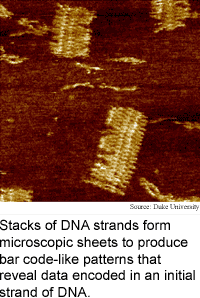
DNA makes nano barcode
By
Kimberly Patch,
Technology Research NewsTo keep Moore's Law going -- the tenet that computer speed will roughly double every 18 months -- manufacturers must make faster circuits, and that usually means making them smaller. If an electronic signal has less distance to travel, it will make the trip more quickly.
But as the components that make up electronic devices grow smaller it is becoming increasingly difficult for manufacturers to assemble them using traditional lithography methods, which employ light and chemicals to etch materials into shape. The transistors that form the bulk of the Pentium 4 computer chip, for instance, are already about 130 nanometers across, which is one-tenth the girth of an E. coli bacterium, or about the size of a row of 1,300 hydrogen atoms.
Lithography is ultimately limited in scale to the wavelength of light, said John Reif, a professor of computer science at Duke University. "Within one or two decades, the ultimate limitations of these top-down patterning methods will be reached," he said.
Another tack is assembling materials from the bottom up -- molecule-by-molecule.
Reif and several colleagues at Duke University have moved the bottom-up method a step forward by programming strands of synthetic DNA to self-assemble into a structure that makes the pattern encoded in a DNA strand readable by microscope.
Key to the method is coaxing columns of looped and non-looped strands of DNA stack into a barcode-like lattice.
DNA is made up of sequences of four bases - adenine, cytosine, guanine and thymine -- attached to a sugar-phosphate backbone. Complementary bases combine -- thiamine with adenine, and cytosine with guanine -- to form the familiar double-stranded helix of biological DNA.
The researchers used a single DNA "scaffolding" strand that contained sections of base sequences that were complementary to portions of DNA barcoding strands. They used two types of DNA barcoding strands -- strands that contained hairpin loops, and strands that did not. The barcoding strands also contained sections of base sequences that caused barcoding strands to combine with like barcoding strands.
The researchers mixed the scaffolding strand with barcoding strands to form a two-dimensional lattice, with an initial row of barcoding strands ordered by the scaffolding strand and additional barcoding strands stacked up on the originals, forming columns with loops and columns without loops. The columns were large enough that they could be sensed with an atomic force microscope and read like a barcode. "The barcode patterns... are determined by a scaffold strand of synthetic DNA. The other strands of DNA assemble around the scaffold strand to form the 2D barcode patterned lattice," said Reif.
The researchers programmed the process to produce two different barcodes -- 01101 and 10010. The prototype DNA barcodes stored the five bits of information in a 75-nanometer long lattice of DNA.
The method is "a nice advance in assembling nano-objects," said David Harlan Wood, a professor of computer science at the University of Delaware. The ability to directly observe the assembly by looking through a microscope at the loops makes nano construction more practical, he said. "Readout techniques are sorely needed for DNA computing," he added.
This type of readout, however, is limited by the number of distinct objects. "When many multiple molecules are important, other methods, such as biochips, may be more appropriate," said Wood.
The method could eventually be used to make templates that will enable molecule-by-molecule construction of electronic circuits, said Reif. The process should yield more complicated patterns than columns if the scaffolding strand is wound back and forth, according to Reif. "Using these patterned DNA lattices as scaffolds, we intend... to self-assemble molecular electronic circuit components... with the goal of forming molecular-scale electronic circuitry," said Reif.
Molecular electronics and robotics components can be precisely positioned at specific locations on such a scaffolding, according to Reif.
There have been notable successes in constructing individual molecular components like carbon nanotubes, said Reif. The DNA scaffolding is one way to hold, shape and assemble these molecular components into complex machines and systems, he said.
The method could be ready for practical use in five to eight years, according to Reif
Reif's research colleagues were Hao Yan, Thomas H. LaBean and Liping Feng. The work appeared in the June 23, 2003 Proceedings of the National Academy of Sciences. The research was funded by the Defense Advanced Research Projects Agency (DARPA), the Air Force Office of Scientific Research (AFOSR), and the National Science Foundation (NSF).
Timeline: 5-8 years
Funding: Government
TRN Categories: Biological, Chemical, DNA and Molecular Computing; Nanotechnology
Story Type: News
Related Elements: Technical paper, "Directed Nucleation Assembly of DNA Tile Complexes for Barcode-Patterned Lattices," Proceedings of the National Academy Of Sciences, June 23, 2003.
Advertisements:
July 2/9, 2003
Page One
DNA makes nano barcode
Study reveals Net's parts
Recommenders can skew results
Light pipes track motion
News briefs:
Material helps bits beat heat
Process puts nanotubes in place
Printing method makes biochips
Tiny T splits light
Tiny walls sprout nanowires
Big sites hoard links

News:
Research News Roundup
Research Watch blog
Features:
View from the High Ground Q&A
How It Works
RSS Feeds:
News
Ad links:
Buy an ad link
| Advertisements:
|
 |
Ad links: Clear History
Buy an ad link
|
TRN
Newswire and Headline Feeds for Web sites
|
© Copyright Technology Research News, LLC 2000-2006. All rights reserved.